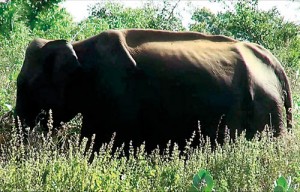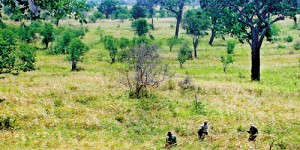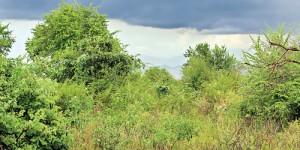News
A shadow of their once majestic selves
Skin and bones!
These are the haunting images of the once ‘majestic’ elephants of the Uda Walawe National Park.

A cow elephant with bones sticking out. Pic by Dr. Sumith Pilapitiya
Trapped within the park, surrounded by tightly-drawn electric fences, bull, cow and even baby elephants are starving to death, the Sunday Times learns. The safe haven has turned into a living hell which is unable to meet even the basic necessity of food of these elephants, turning them into emaciated ghosts of their former selves.
“These elephants searching the scrub jungle for whatever morsel of nutritious grass available are a pathetic and heartrending sight,” laments Dr. Prithiviraj Fernando of the Centre for Conservation and Research, dubbing it the “big issue of scarecrow elephants”.
A frequent visitor to the Uda Walawe Park which is reported to be home to more than a thousand elephants, Dr. Fernando delves into history to answer how this situation has come about.
What is happening at Uda Walawe is an “artificial thing”, according to him. Uda Walawe is in the intermediate zone where originally the natural vegetation comprised tall forest. It would have been a closed canopy forest with huge trees but little undergrowth.
From time immemorial, the Sunday Times learns, villagers in the few scattered hamlets in the area had engaged in chena (slash-and-burn)

A gaunt elephant looking for food
cultivations, clearing some parts of the forest, setting fire to that area and then growing finger-millet and vegetables and a little paddy around the old tanks dotting the land. They had been surviving as subsistence farmers.
Dr. Fernando jogs the collective memory of Sri Lankans to hark back to the time, with no televisions around, when people would gather by radios to be engrossed in the tale of ‘Muwan Pelessa’ with its base of ‘Seenuggala’ in Uda Walawe.
In the 1960s came the Uda Walawe Project under which the Walawe ganga was dammed to irrigate the lands. The downside was that in addition to the settlers brought in by the government in the 1960s and ’70s, there was also a flood of encroachments. This resulted not only in large tracts extending down to Mattala going under chena cultivations but also the ‘side business’ of massive logging, he points out.
With large areas being cleared, land conditions became more suitable for savannah grasslands, which in turn benefited the elephants, the Sunday Times learns, looking at the passage of time. However, irrigation, development and more people downstream of the Walawe Ganga were the ideal breeding ground for the human-elephant conflict (HEC).
It was to ease the HEC that the Uda Walawe National Park was established and many drives undertaken by the Department of Wildlife Conservation (DWC) to chase the elephants into it, says Dr. Fernando, pointing out that in the 1980s the Sevanagala sugar factory put up an electric fence on the boundary of the park adjacent to the road to ward off the elephants. People were settled beyond the fence and by and by it became possibly the most successful electric fence boundary in Sri Lanka between development activity and elephants.

Dr. Prithiviraj Fernando
The trouble began though when later the fence was extended to surround the whole of the Uda Walawe Park. The fences on the eastern and northern boundaries cut off the access of elephants to Forest Department land, adjacent and beyond, reiterates this researcher who is a member of the Asian Elephant Specialist Group as well as a Research Associate of the Smithsonian Institution of the United States of America.
Initially, however, there were no issues as the park with its savannah grasslands, mostly comprising Guinea grass (Megathyrsus maximus, earlier known as Panicum maximum), being good elephant habitat. This was a high-protein grass brought as fodder for cattle in the 1900s which had later got naturalised across the country. “It was very good fodder for all herbivores including elephants,” says Dr. Fernando.
The cycle was for the grasslands to thrive during the wet season and die off during the dry season (June to September) but the elephants at Uda Walawe never went without food because the water in the tanks would recede during the dry season, as it was let out for cultivation, allowing a different shorter grass to grow on the tank-bed, the Sunday Times learns.

The grasslands of Uda Walawe in 2006 providing plenty of food for elephants. (Pix top, above left and right by Dr. Jennifer Pastorini)
“So the elephants had the best of both worlds, be it the dry or wet season,” he says, adding that the grasslands are not a natural ecosystem in a tropical country like Sri Lanka, particularly in the lowlands. Grasslands would only “persist” if there is some “disturbance” which came in the ‘natural’ form of annual flooding for the tank-bed grasslands and fire for Guinea grasslands. Of course, much of the Guinea grassland fires were ‘unnatural or artificial’ being mostly set by cattle-herders.
The fires would burn down large areas of Uda Walawe on an annual basis, but the grasses did not die. Although the dry above-ground parts of the grasses burnt to the ground, as soon as the rains came there would be lush and rapid re-growth from the surviving rootstock. But the general thinking was that fire was detrimental as it destroyed the land and killed off small animals. It was in this context that the DWC would rush in and suppress any fires that broke out.
Fire-suppression possibly resulted in accelerating the change of grasslands to scrub through a process of ‘succession’, said Dr. Fernando, detailing ‘succession’ as the natural progression of vegetation from bare ground to lichens, mosses, ferns, grasses, herbs, shrubs and trees, creating a secondary forest and finally a primary forest.
In Uda Walawe, ‘succession’ was prevented through the annual flooding of the reservoir-bed which stymied grasslands from moving to the next stage, while in the Guinea grassland the reversal or retardation of ‘succession’ was performed by fire, it is understood.

How the landscape has changed, leaving no food for the elephants this year.
In addition to elephants, meanwhile, cattle and buffaloes have also been a feature of the park which may have aided the retardation process at low densities. But the extremely high numbers of these animals subsequently, in the tens of thousands, have probably contributed to eliminating the grasslands, says Dr. Fernando.
Referring to the electric fences put up by the DWC, this elephant-expert points out that in the past these fences periodically went into disrepair and disuse every few years. At such times, the park elephants regained access to adjacent Forest Department areas. However, in the past few years with better maintenance of the fences more elephants have got trapped in the park, with the year-round high densities possibly having a bigger impact on the Guinea grasslands and hastening ‘succession’ of the land.
Another cause for worry is exotic invasive species such as Lantana (Gandapana) and Eupatorium (Japan lantana or Podisingho-maran) which are shrubs taking control of the grasslands, he says, asking whether laboriously pulling them out is the answer. If so it would have to be done regularly and systematically, which would be costly. However, it is also a complex situation with annual fires possibly retarding their establishment but once established, fires possibly promoting their growth.
“The situation will only get worse,” stresses Dr. Fernando, adding that when comparing what Uda Walawe looked like 10 years ago and now, the transition is amazing. The grasslands ideal for elephants have fast disappeared to be replaced by scrub jungle, which will continue to become secondary forests.
He laments that as a result, elephants will have less and less food and numbers will decrease. Together with that the habitat will become denser, reducing elephant-sightings.
It seems to be tolling the death knell for the Uda Walawe elephants and for the park itself as a premier elephant-viewing destination.
| Don’t wait for Uda Walawe to turn into an elephant graveyard With clear danger signals that the situation in Uda Walawe is deteriorating rapidly over the years, Dr. Fernando says that just last year the DWC captured six baby elephants which were very weak from the park and brought them to the Elephant Transit Home. Opening the fences between the park and the adjacent Forest Department areas would ease the pressure temporarily and buy time, he says. Urging that these experiments need to be started soonest, Dr. Fernando reiterates that it would be the only way to find out what conditions would restore the grasslands. “Start right now, otherwise Uda Walawe will turn out to be an elephant graveyard,” he says, adding that there simply is no magic wand and informed action is the need of the hour. |

